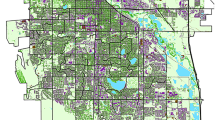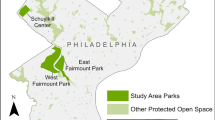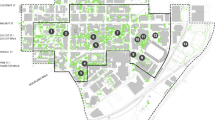Abstract
Present-day spatial patterns of urban tree canopy (UTC) are created by complex interactions between various human and biophysical drivers; thus, urban forests represent legacies of past processes. Understanding these legacies can inform municipal tree planting and canopy cover goals while also addressing urban sustainability and inequity. We examined historical UTC cover patterns and the processes that formed them in the cities of Chelsea and Holyoke, Massachusetts using a mixed methods approach. Combining assessments of delineated UTC from aerial photos with historical archival data, we show how biophysical factors and cycles of governance and urban development and decay have influenced the spatiotemporal dynamics of UTC. The spatially explicit UTC layers generated from this research track historical geographic tree distribution and dynamic change over a 62-year period (1952–2014). An inverse relationship was found between UTC and economic prosperity: while canopy gains occurred in depressed economic periods, canopy losses occurred in strong economic periods. A sustainable increase of UTC is needed to offset ongoing losses and overcome historical legacies that have suppressed UTC across decades. These findings will inform future research on residential canopy formation and stability, but most importantly, they reveal how historical drivers can be used to inform multi-decadal UTC assessments and the creation of targeted, feasible UTC goals at neighborhood and city scales. Such analyses can help urban natural resource managers to better understand how to protect and expand their cities’ UTC over time for the benefit of all who live in and among the shade of urban forests.









Similar content being viewed by others
References
Ancestry. Newspapers.com. https://www.newspapers.com. Accessed Jan 2021
Baily B, Inkpen R (2013) Assessing historical saltmarsh change; an investigation into the reliability of historical saltmarsh mapping using contemporaneous aerial photography and cartographic data. J Coast Conserv 17(3):503–514
Berland A (2012) Long-term urbanization effects on tree canopy cover along an urban–rural gradient.Urban Ecosyst 15(3):721–738. https://doi.org/10.1007/s11252-012-0224-9
Berland A, Schwarz K, Herrmann DL, Hopton ME (2015) How environmental justice patterns are shaped by place: terrain and tree canopy in Cincinnati, Ohio, USA. Cities Environ 8(1):1
Berland A, Locke DH, Herrmann DL, Schwarz K (2020) Beauty or Blight? AbuNdant Vegetation In The Presence Of Disinvestment Across Residential Parcels And Neighborhoods in Toledo, OH. Front Ecol Evol 8:334
Bonney MT, He Y (2019) Attributing drivers to spatio-temporal changes in tree density across a suburbanizing landscape since 1944. Landsc Urban Plan 192:103652
Borges-Méndez RF (2007) The Latinization of Lawrence: Migration, settlement, and incorporation of Latinos in a small town of Massachusetts. Montero-Sieburth Melendez 2007a:228–253
Brook BW, Bowman DM (2006) Postcards from the past: charting the landscape-scale conversion of tropical Australian savanna to closed forest during the 20th century. Landsc Ecol 21(8):1253–1266
Brownlow A (2006) An archaeology of fear and environmental change in Philadelphia. Geoforum 37(2):227–245
Brunner J, Cozens P (2013) ‘Where have all the trees gone?’ Urban consolidation and the demise of urban vegetation: a case study from Western Australia. Plan Pract Res 28(2):231–255
Chojnacky DC, Smith-McKenna EK, Johnson LY, McGee JA, Chojnacky CC (2020) Evaluating urban canopy cover before and after housing redevelopment in Falls Church, Virginia, USA. Arboriculture Urban Forestry 46(1):12–26
City of Chelsea (2005) Design Guidelines for the Residential 3 (R3), Retail Business 2 (BR2), and Light Industrial/Office 2 (LI2) Districts, Revised 2013. City of Chelsea, pp. 1–4. www.chelseama.gov
City of Chelsea (2006) Capital Improvement Program 2006–2010. City of Chelsea, pp. 1–99. www.chelseama.gov
City of Chelsea (2008) Annual Budget, Fiscal Year 2008. City of Chelsea, pp. 1–152. www.chelseama.gov
City of Chelsea (2010) Capital Improvement Program 2010–2014. City of Chelsea, pp. 1–72. www.chelseama.gov
City of Chelsea (2014) Capital Improvement Program 2014–2018. City of Chelsea, pp. 1–89. www.chelseama.gov
City of Chelsea (2016) Tree Management Plan, City of Chelsea, Massachusetts. Davey Resource Group, pp. 1–83. www.chelseama.gov
City of Holyoke (1920–1963) Municipal Register of the City of Holyoke. The Holyoke City Hall Collection, Wistariahurst Museum, Collection L2011.028, Wistariahurst Museum, Holyoke, MA
City of Holyoke (2017) The Holyoke Historic Preservation Plan. City of Holyoke, pp.1–247. www.holyoke.org
Curran MP (1960) A case history in zoning: the Holyoke, Massachusetts experience. ScholarWorks@UMass Amherst
Eisenman TS, Flanders T, Harper RW, Hauer RJ, Lieberknecht K (2021) Traits of a bloom: a nationwide survey of US urban tree planting initiatives (TPIs). Urban Forestry Urban Green 61:127006
Gillespie TW, Pincetl S, Brossard S, Smith J, Saatchi S, Pataki D, Saphores JD (2012) A time series of urban forestry in Los Angeles. Urban Ecosyst 15(1):233–246
Gillespie CB (1898) Souvenir Edition of the Chelsea Gazette Issued by Request of the Board of Trade and Entitled The City of Chelsea, Massachusetts: Her History, Her Achievements, Her Opportunities. Chelsea Gazette
Haaland C, van Den Bosch CK (2015) Challenges and strategies for urban green-space planning in cities undergoing densification: A review. Urban Forestry Urban Green 14(4):760–771
Haase D, Haase A, Rink D (2014) Conceptualizing the nexus between urban shrinkage and ecosystem services. Landsc Urban Plan 132:159–169
Hardy-Fanta C, Gerson J (2002) Latino politics in Massachusetts: struggles, strategies, and prospects (Vol. 4). Routledge
Harper WE (1973) The Story of Holyoke. Centennial Committee. https://archive.org/details/storyofholyoke00harp/page/n243/mode/2up. Accessed 4/2021
Hoffman JS, Shandas V, Pendleton N (2020) The effects of historical housing policies on resident exposure to intra-urban heat: a study of 108 US urban areas. Climate 8(1):12
Hughes ML, McDowell PF, Marcus WA (2006) Accuracy assessment of georectified aerial photographs: implications for measuring lateral channel movement in a GIS. Geomorphology 74(1-4):1–16
Jacobson-Hardy M, Weir RE (1992) Faces, machines, and voices: the fading landscape of papermaking in Holyoke, Massachusetts. Mass Rev 33(3):361–384
Jim CY (2004) Green-space preservation and allocation for sustainable greening of compact cities. Cities 21(4):311–320
Kane K, Connors JP, Galletti CS (2014) Beyond fragmentation at the fringe: A path-dependent, high-resolution analysis of urban land cover in Phoenix, Arizona Appl Geogr 52:123–134
Lake CC (2011) Chelsea under fire: urban industrial life, crisis, and the trajectory of Jewish and Latino Chelsea. Boston College. http://hdl.handle.net/2345/1998
Locke DH, Landry SM, Grove JM, Roy Chowdhury R (2016) Whatas scale got to do with it? Models for urban tree canopy. J Urban Ecol 2(1):1–16
Locke DH, Romolini M, Galvin M, O’Neil-Dunne JP, Strauss EG (2017) Tree canopy change in coastal Los Angeles, 2009-2014. Cities Environ (CATE) 10(2):3
Locke DH, Hall B, Grove JM, Pickett ST, Ogden LA, Aoki C, Boone CG, O’Neil-Dunne JP (2021) Residential housing segregation and urban tree canopy in 37 US Cities. npj Urban Sustain 1(1):1–9
Massachusetts DCR (2008) DCR urban & community forestry grant history. http://maps.massgis.state.ma.us/dcr/forestry/grant_history.html
MassGIS (2019) USGS color ortho imagery (2013/2014). https://docs.digital.mass.gov/dataset/massgis-data-usgs-color-ortho-imagery-20132014
MassLive (2011) $14.5 million project to renovate Holyoke Public Library scheduled to begin in December. MassLive, 17 November 2011
MassLive (2012) Holyoke community field to reopen after $3.1 million renovation. MassLive, 01 June 2012
MassLive (2014) Holyoke wastewater treatment plant: millions of gallons daily get high-tech cleaning, but deficit likely to yield higher bills. MassLive, 02 July 2014
McPherson EG, Luttinger N (1998) From nature to nurture: the history of Sacramento’s urban forest. J Arboriculture 24(2):72–88
Merry K, Siry J, Bettinger P, Bowker JM (2014) Urban tree cover change in Detroit and Atlanta, USA, 1951–2010. Cities 41:123–131
Merse CL, Buckley GL, Boone CG (2009) Street trees and urban renewal: a Baltimore case study. Geographical Bull 50(2):65–81
Morgan JL, Gergel SE, Coops NC (2010) Aerial photography: a rapidly evolving tool for ecological management. BioScience 60(1):47–59
Neumann T (2016) Remaking the rust belt: The postindustrial transformation of North America. University of Pennsylvania Press
Nguyen VD, Roman LA, Locke DH, Mincey SK, Sanders JR, Fichman ES, Duran-Mitchell M, Tobing SL (2017) Branching out to residential lands: missions and strategies of five tree distribution programs in the US. Urban Forestry Urban Green 22:24–35
Nix S, Roman LA, Healy M, Rogan J, Pearsall H (2022) Linking tree cover change to historical management practices in urban parks. Landscape Ecology
Nowak DJ, Greenfield EJ (2018) Declining urban and community tree cover in the United States. Urban Forestry Urban Green 32:32–55
Nowak DJ, Greenfield EJ (2020) The increase of impervious cover and decrease of tree cover within urban areas globally (2012–2017). Urban Forestry Urban Green 49:126638
Nowak DJ, Ellis A, Greenfield EJ (2022) The disparity in tree cover and ecosystem service values among redlining classes in the United States. Landsc Urban Plan 221:104370
O’Neil-Dunne JP, MacFaden SW, Royar AR, Pelletier KC (2013) An object-based system for LiDAR data fusion and feature extraction. Geocarto Int 28(3):227–242
O’Neil-Dunne J (2017) Tree Canopy in Cambridge, MA: 2009–2014, University of Vermont Spatial Analysis Laboratory. University of Vermont, pp. 1–9
Ogden LA, Aoki C, Grove JM, Sonti NF, Hall W, Locke D, Pickett ST, Avins M, Lautar K, Lagrosa J (2019)Forest ethnography: An approach to study the environmental history and political ecology of urban forests. Urban Ecosyst 22(1):49–63
Ossola A, Locke D, Lin B, Minor E (2019) Greening in style: urban form, architecture and the structure of front and backyard vegetation. Landsc Urban Plan 185:141–157
Parmehr EG, Amati, M, Fraser CS (2016) Mapping urban tree canopy cover using fused airborne LiDAR and satellite imagery data. ISPRS Annals of Photogrammetry, Remote Sensing & Spatial Information Sciences, 3(7).
Pham T, Apparicio P, Landry S, Lewnard J (2017) Disentangling the effects of urban form and socio-demographic context on street tree cover: a multi-level analysis from Montréal. Landsc Urban Plan 157:422–433
Pontius jr RG, Shusas E, McEachern M (2004) Detecting important categorical land changes while accounting for persistence Agric Ecosys Environ 101(2–3):251–268
Presley Associates Inc. (1999) Cultural Landscape Report, Wistariahurst Museum, Holyoke Massachusetts. Presley Associates Inc., pp 1–133
Richardson JJ, Moskal LM (2014) Uncertainty in urban forest canopy assessment: Lessons from Seattle, WA, USA. Urban For Urban Green 13(1):152–157
Roman LA, Walker LA, Martineau CM, Muffly DJ, MacQueen SA, Harris W (2015) Stewardship matters: case studies in establishment success of urban trees. Urban For Urban Green 14(4):1174–1182
Roman LA, Catton IJ, Greenfield EJ, Pearsall H, Eisenman TS, Henning JG (2021) Linking urban tree cover change and local history in a post-industrial city. Land 10(4):403
Roman LA, Fristensky JP, Eisenman TS, Greenfield EJ, Lundgren RE, Cerwinka CE, Hewitt DA, Welsh CC (2017) Growing canopy on a college campus: understanding urban forest change through archival records and aerial photography. Environ Manag 60(6):1042–1061
Roman LA, Pearsall H, Eisenman TS, Conway TM, Fahey RT, Landry S, Vogt J, van Doorn NS, Grove JM, Locke DH, Bardekjian AC (2018) Human and biophysical legacies shape contemporary urban forests: a literature synthesis. Urban For Urban Green 31:157–168
Rothstein R (2017) The color of law: A forgotten history of how our government segregated America. Liveright Publishing
Roy S, Byrne J, Pickering C (2012) A systematic quantitative review of urban tree benefits, costs, and assessment methods across cities in different climatic zones. Urban For Urban Green 11(4):351–363
Sanborn Map Company, 1956. Sanborn Fire Insurance Map from Holyoke, Hampden County, Massachusetts; Republished 1956. Map. Retrieved from the Library of Congress, https://www.loc.gov/item/sanborn03751_006/
Schwarz K, Fragkias M, Boone CG, Zhou W, McHale M, Grove JM, O’Neil-Dunne J, McFadden JP, Buckley GL, Childers D, Ogden L (2015) Trees grow on money: urban tree canopy cover and environmental justice. PloS ONE 10(4):e0122051
The Berkshire Eagle (1954) Ex-Hurricane Slaps County, Felling Trees and Branches. The Berkshire Eagle, 16 October 1954
The Boston Globe (1974a) Dutch elm disease cure called failure. The Boston Globe, 26 Sep 1974
The Boston Globe (1974b) Naval hospital closes in Chelsea. The Boston Globe, 28 June 1974
The Boston Globe (1983) Housing blossoms at Chelsea Naval Hospital. The Boston Globe, 30 July 1983
The Boston Globe (1991a) A city’s fiscal free fall. The Boston Globe, 7 Sep 1991
The Boston Globe (1991b) New England is coping with Bob’s legacy. The Boston Globe, 25 Aug 1991
The Boston Globe (1992) Lesson from Chelsea. The Boston Globe, 27 Feb 1992
The Boston Globe (1994) Chelsea looks ahead to life after receivership. The Boston Globe, 12 Mar 1994
The Boston Globe (2001) Chelsea gets down to a serious cleanup. The Boston Globe, 18 Feb 2001
The Boston Globe (2007) Community Briefing, Chelsea Mystic Mall Proposal. The Boston Globe, 20 May 2007
The Boston Globe (2012) Power Play. The Boston Globe, 9 July 2012
The Boston Globe (2013) No takers for Forbes Park development at auction. The Boston Globe, 1 Aug 2013
The Boston Globe (2016a) Holyoke aims for long-term revival. The Boston Globe, 3 April 2016
The Boston Globe (2016b) Skate park is a bright spot in Holyoke. The Boston Globe, 10 April 2016
The Hadley Falls Company (1853) Report on the History and Present Condition of the Hadley Falls Company at Holyoke, Massachusetts. Printed by John Wilson & Son, pp. 32. https://archive.org/details/reportofhistoryp00hadl/mode/2up
The North Adams Transcript (1954) Hurricane Carol Tree Damage Costs $270,000. The North Adams Transcript, 14 Oct 1954
Del Tredici P (2010) Spontaneous urban vegetation: reflections of change in a globalized world. Nat Cult 5(3):299–315
US Census (1930) Decennial Census, Population and Housing. Population, Vol 1. https://www.census.gov/prod/www/decennial.html
US Census (1980) Decennial Census, Population and Housing. Population, Vol 1. https://www.census.gov/prod/www/decennial.html
US Census (2019) 2015–2019 American Community Survey 5-Year Estimates. Tables DP02, DP03, and DP05. https://www.census.gov/acs/www/data/data-tables-and-tools/data-profiles/
US Census (2021) Decennial Census, Population and Housing. P.L. 94–171 Redistricting Data. https://www.census.gov/programs-surveys/decennial-census/decade.2020.html
Valley Health & Life (2018) Celebrating 125 years of service. Valley Health & Life, Summer 2018, pp. 16. https://www.holyokehealth.com/about-us/our-magazine/
Vogt J (2018) “Ships that pass in the night”: Does scholarship on the social benefits of urban greening have a disciplinary crosstalk problem? Urban For Urban Green 32:195–199
Wachter SM, Zeuli KA (2013) Revitalizing American Cities. University of Pennsylvania Press
Walton JT, Nowak DJ, Greenfield EJ (2008) Assessing urban forest canopy cover using airborne or satellite imagery. Arboriculture Urban For 34(6):334–340
Watkins SL, Gerrish E (2018) The relationship between urban forests and race: a meta-analysis. J Environ Manag 209:152–168
Young RF (2013) Mainstreaming urban ecosystem services: a national survey of municipal foresters. Urban Ecosyst 16(4):703–722
Zhou W, Huang G, Pickett ST, Cadenasso ML (2011) 90 years of forest cover change in an urbanizing watershed: spatial and temporal dynamics. Landsc Ecol 26(5):645–659
Zhou W, Huang G, Pickett ST, Wang J, Cadenasso ML, McPhearson T, Grove JM, Wang J (2021) Urban tree canopy has greater cooling effects in socially vulnerable communities in the US. One Earth 4(12):1764–1775
Acknowledgements
This research was supported by the Garden Club of America Fellowship in Urban Forestry and by the Human-Environmental Regional Observatory at Clark University. We thank Eileen Crosby from the Holyoke Public Library for generously helping us access city archival data and history as well as Penni Martorell from Wistariahurst for providing Holyoke budgetary documents and Wistariahurst history documents, for offering her archival expertise and reviewing this work. We are grateful to Bob Collins from the Chelsea Public Library who shared historical documents, as well as his own lived experiences in Chelsea. We also thank Julie Coop from the Massachusetts Department of Conservation and Recreation who provided tree grant history data and Dexter Locke (USDA Forest Service) and Jacque Healy who helped review the paper. The opinions and findings expressed in this paper are those of the authors and should not be construed to represent any official USDA or US Government determination or policy.
Author Contributions
All authors contributed to the study conception and design. Material preparation, data collection and analysis were performed by MH, and SN. The first draft of the paper was written by MH and all authors commented on and refined further versions of the paper. All authors read and approved the final paper.
Funding
This research was supported by the Garden Club of America Fellowship in Urban Forestry.
Author information
Authors and Affiliations
Corresponding author
Ethics declarations
Conflict of Interest
The authors declare no competing interests.
Additional information
Publisher’s note Springer Nature remains neutral with regard to jurisdictional claims in published maps and institutional affiliations.
Rights and permissions
About this article
Cite this article
Healy, M., Rogan, J., Roman, L.A. et al. Historical Urban Tree Canopy Cover Change in Two Post-Industrial Cities. Environmental Management 70, 16–34 (2022). https://doi.org/10.1007/s00267-022-01614-x
Received:
Accepted:
Published:
Issue Date:
DOI: https://doi.org/10.1007/s00267-022-01614-x




